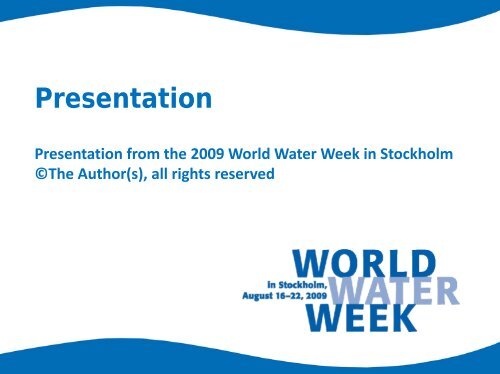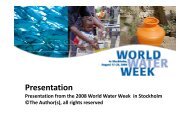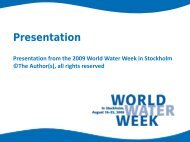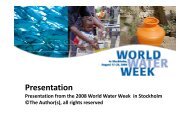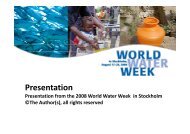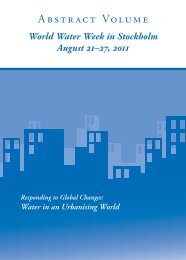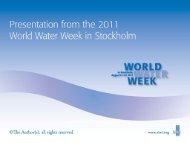A Case Study of the Massive Zeyzoun Dam Collapse. Dr
A Case Study of the Massive Zeyzoun Dam Collapse. Dr
A Case Study of the Massive Zeyzoun Dam Collapse. Dr
Create successful ePaper yourself
Turn your PDF publications into a flip-book with our unique Google optimized e-Paper software.
World Water Week 200916-22 AugustWorkshop 5 – Safe Water Services in Post-conflictand Post-disaster Context19 August
•General facts about SyriaArea: 185,000 Km2, Population:18 Million, Syria depends on surface and ground water (springs andwells) for agricultural sector and domestic supply. Agriculture is <strong>the</strong> largest consumer <strong>of</strong> water (about85%) and <strong>the</strong> economy <strong>of</strong> <strong>the</strong> country depends directly on it (30%GDP). Water management has focusedin <strong>the</strong> last 4 decades on water supply, (160) dams were built, large irrigation projects to supply cities andvillages with water to encourage agricultural and industrial expansion.
Water Challenges in Syriaa) Aridity (low rainfall and high evaporation),b) Population growths,c) Deterioration in water quality,d) Social and economic development,e) Complexity in hydropolitics (watersharing/conflict) (almost 70% <strong>of</strong> total resources),f) Efficiency in water distribution and use,g) Public awareness and education,h) Water strategies/ institution/human resources,i) Competition among agriculture, industry andcities for limited water supplies is alreadyconstraining development efforts in many parts <strong>of</strong><strong>the</strong> country like <strong>Dam</strong>ascus, Aleppo, Homs andHama, and this will intensify, causing difficultiesin specific regions.PalmyraSebkhaThe Oasis•
<strong>Zeyzoun</strong> <strong>Dam</strong> <strong>Collapse</strong> June 2002The <strong>Zeyzoun</strong> earth dam was <strong>the</strong> fourth largest dam inSyria (hight 43. length 5 km, located some 90 kmnorth-west <strong>of</strong> <strong>the</strong> town <strong>of</strong> Hama, approximately 300 kmnorth <strong>of</strong> <strong>Dam</strong>ascus, started developing cracks in <strong>the</strong>retention wall in <strong>the</strong> early hours <strong>of</strong> 4 June 2002. Ataround 15:00, <strong>the</strong> initial trickle <strong>of</strong> water give way to amassive outpour, which led to <strong>the</strong> progressive collapse<strong>of</strong> a section <strong>of</strong> <strong>the</strong> dam’s wall approximately 40 metershigh and 100 meters wide.In about one hour, over 70 million cubic meters <strong>of</strong>water flooded an area estimated in 60 square km.The flooded area included mostly agricultural land,mercifully with a relatively low population density.The following villages were affected: <strong>Zeyzoun</strong>(population 1,000), Al-Imshiak (1,344), Gargoor(2,366) and Tel Wasit (1,696).
<strong>Zeyzoun</strong> <strong>Dam</strong><strong>Collapse</strong> June2002This false-color image takenon June 5, 2002, (bottom) by<strong>the</strong> Moderate-resolutionImaging Spectroradiometer(MODIS) instrument aboardNASA’s Terra satellite shows<strong>the</strong> extent <strong>of</strong> <strong>the</strong> flooding.Normally, <strong>the</strong>re would be nowater present in <strong>the</strong> center <strong>of</strong><strong>the</strong> image (top, acquired onJune 3, 2002).In this false-color image, <strong>the</strong>ground is sage green andrusty orange, and water isblack. Clouds appear pink.Before <strong>Collapse</strong>After <strong>Collapse</strong>
<strong>Zeyzoun</strong> <strong>Dam</strong> <strong>Collapse</strong> June 20021) Local communities were devastated by <strong>the</strong>collapse <strong>of</strong> <strong>the</strong> <strong>Zeyzoun</strong> dam, north <strong>of</strong> <strong>the</strong> city <strong>of</strong>Hama, bursts, dumping nearly all <strong>of</strong> its 71m cubicmetres <strong>of</strong> water over 60 square km <strong>of</strong> farmland andswamping several villages.2) Over and above <strong>the</strong> already serious impact <strong>of</strong> <strong>the</strong>disaster on <strong>the</strong> population directly affected (loss <strong>of</strong>houses, property, agricultural products and livestock),3) It must be considered that <strong>the</strong> economy <strong>of</strong> an entireagricultural region would be severely affected by <strong>the</strong>sudden disappearance <strong>of</strong> <strong>the</strong> major source <strong>of</strong>irrigation water available.4) It was confirmed that some 20 people have beenkilled and over 10,000 people were directly affectedby this incident to varying degrees, with at least 2,000rendered completely homeless.
<strong>Zeyzoun</strong> <strong>Dam</strong> <strong>Collapse</strong> June 20025) <strong>Dam</strong>age to human settlements varies from <strong>the</strong> totaldestruction <strong>of</strong> <strong>the</strong> village <strong>of</strong> <strong>Zeyzoun</strong>, located next to <strong>the</strong>dam, to partial destruction <strong>of</strong> settlements locatedbetween 2 and 3 km from <strong>the</strong> dam, to flooding <strong>of</strong> <strong>the</strong>ground floor <strong>of</strong> houses in villages fur<strong>the</strong>r away.6) According to <strong>the</strong> latest estimates, <strong>the</strong>re were about251 houses completely destroyed, some 121 partiallydestroyed, and about 200 damaged. Sixty kilometers <strong>of</strong>roads were reported by <strong>the</strong> government to be damaged.7) Also damage on <strong>the</strong> electric power lines and <strong>the</strong>telecommunication system was reported.8) Two schools were reportedly completely destroyedand at least three damaged.9) One health center was partially damaged but stillfunctioning and one <strong>of</strong> <strong>the</strong> storehouses <strong>of</strong> <strong>the</strong>agricultural credit bank was reported to be damaged.10) It is estimated that up to 8,000 hectares <strong>of</strong> arableland have been submerged for up to a week.
National ResponseSyrian Central Government: The Government <strong>of</strong> Syria has set up a NationalEmergency Committee chaired by <strong>the</strong> Prime Minister. The Central Government hasallocated <strong>the</strong> necessary financial resources, and has provided food and non-foodrelief to <strong>the</strong> affected people.Hama Provincial Government: <strong>the</strong> Provincial Government <strong>of</strong> Hama established anEmergency Co-ordination Committee, chaired by <strong>the</strong> Governor <strong>of</strong> Hama. Thiscommittee includes all principal provincial sectors.The emergency committee has formed four sub-groups to address specific areas <strong>of</strong>interest, namely an assessment committee to assess damage to agriculture,infrastructure, public property and private property.The military authorities: have been involved in <strong>the</strong> response to this incident,particularly for <strong>the</strong> early evacuation <strong>of</strong> people most at risk.The Syrian Red Crescent Society: has channelled <strong>the</strong> assistance <strong>of</strong> <strong>the</strong> RedCross/Red Crescent Movement (including donations from <strong>the</strong> United Arab EmiratesRed Crescent and <strong>the</strong> incoming substantial assistance from <strong>the</strong> InternationalFederation <strong>of</strong> <strong>the</strong> Red Cross).
International ResponseUnited Nations Agencies and o<strong>the</strong>r international organizations (OCHA,UNDAC, UNICFE, UNHCR, UNDOF, UNFPA, WFP, WHO, IOM, IFRC):The UN Country Team in Syria, immediately established a coordinating mechanism to bringtoge<strong>the</strong>r <strong>the</strong> UN response and to establish a common interface with government authorities, aswell as with bilateral and multilateral donors.UNDP <strong>of</strong> Syria worked with local authorities on plans in <strong>the</strong> post-disasterrehabilitation project which was designed around 5 pillars:1) A survey <strong>of</strong> <strong>the</strong> socio-economic and environmental situation in <strong>the</strong> aftermath <strong>of</strong> <strong>the</strong>disaster; 2) A technical, economic and environmental study <strong>of</strong> <strong>the</strong> physical rehabilitation <strong>of</strong><strong>the</strong> region including <strong>the</strong> dam and <strong>the</strong> irrigation system; 3) Micro finance pilot schemes tosupport income generating activities; 4) Capacity building for local community participation in<strong>the</strong> rehabilitation process; 5) Building local government capacity in coordination andresource mobilization.Both <strong>the</strong> Syrian authorities and <strong>the</strong> UN Office in Syria provided every possible support for <strong>the</strong>mission, including full access to <strong>the</strong>ir information, documents, and facilities.Bilateral Donors:Algeria, Japan, Iran, Iraq, Italy, Morocco, Saudi Arabia, United Arab Emirates, FrenchCommunication Sans Frontiere.
Disaster ManagementSince <strong>the</strong> failure <strong>of</strong> <strong>Zeyzoun</strong> <strong>Dam</strong> in June 2002, <strong>the</strong> awareness <strong>of</strong> <strong>the</strong> safe dammanagement has been rising rapidly.This disaster has served as an eye-opener for <strong>the</strong> planners and it has indicated <strong>the</strong> perils<strong>of</strong> rapid development in this region and o<strong>the</strong>r similar areas to <strong>the</strong> <strong>Zeyzoun</strong> region.This disaster, as a man-made incident, demonstrates <strong>the</strong> necessity to improve <strong>the</strong>emergency management capacity and contingency planning in <strong>the</strong> country.The role <strong>of</strong> prevention and preparedness is clearly recognized as being <strong>the</strong> mosteffective form <strong>of</strong> defence against disaster. This capacity should be streng<strong>the</strong>ned byappropriate international assistance.
Strategic Goals & ChallengesEffective integration <strong>of</strong> disaster risk and managementconsiderations into sustainable development policies.Challenges & Constraints:1) Laws & legislations which organize <strong>the</strong> work <strong>of</strong> disasters and coordinationmechanisms among <strong>the</strong>m on <strong>the</strong> local & national levels.2) Lack <strong>of</strong> public awareness on general safety measures.3) Lack <strong>of</strong> general safety rules in designing building, establishments andinfrastructure.
Strategic Goals & ChallengesThe development and streng<strong>the</strong>ning <strong>of</strong> institutions, mechanisms andcapacities at all levels, in particular at <strong>the</strong> community level, that cansystematically contribute to building resilience to hazards.Challenges & Constraints:1) Lack <strong>of</strong> qualified & well trained staffs that contributes to different disastermitigation.2) Lack in equipments needed for disaster mitigation.3) Weakness <strong>of</strong> specialized centers in conducting studies & measurements fordisasters prediction and <strong>the</strong> ability to analyze previous disasters for futurebenefits.
Strategic Goals & ChallengesThe systematic incorporation <strong>of</strong> risk reduction approaches into<strong>the</strong> design and implementation <strong>of</strong> emergency preparedness,response and recovery programmes in <strong>the</strong> reconstruction <strong>of</strong>affected communities.Challenges & Constraints1) Lack in accuracy <strong>of</strong> <strong>the</strong> available databases <strong>of</strong> governorates equipmentnecessary for dealing with disasters.2) Lack <strong>of</strong> using modern systems & techniques in disasters managementand lack <strong>of</strong> qualified staff to work on <strong>the</strong>se systems.
OutlookIt is difficult to completely avoid similar accidents in <strong>the</strong> future. Many o<strong>the</strong>r dams exist inSyria, and it is important to take <strong>the</strong> necessary steps for a better prevention andpreparedness arrangements, as well as for an increased awareness <strong>of</strong> existing hazards andassociated risks for surrounding populations.The aims1) Obtain a high ability in disaster reduction & mitigation.2) The ability to analyze disasters for future benefits.3) Providing all citizens with needed awareness level in case <strong>of</strong> any disaster occurs anddealing with it correctly before, during and after disaster.4) using Geionformation technologies (GNSS, GIS, RS) in monitoring and risk reduction
World Water Week 2009Workshop 5 – Safe Water Services in Post-conflict and Post-disaster ContextTHANKYOU


